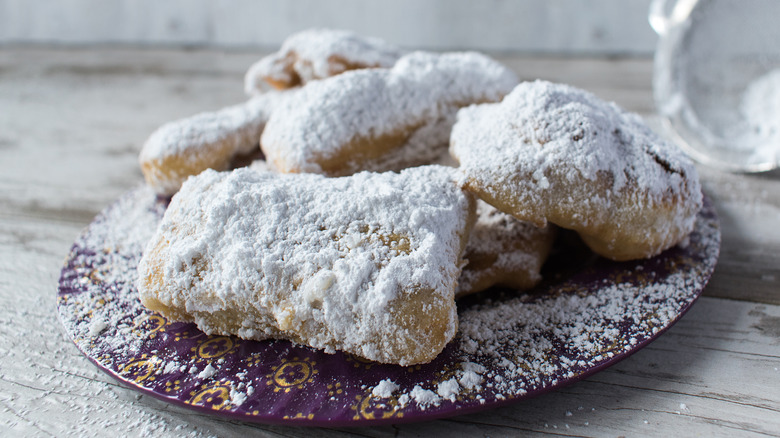The Paper Bag Tip To Ensure A Mess-Free Experience When Coating Beignets
Licking the sugar off your lips after taking the first bite of a hot, fluffy beignet is a heavenly sensory event. But what isn't so much fun is the hellish task of cleaning up the sugar that's settled on the countertop after a glorious session of making these classic deep-fried French pastries at home. Here's how a simple paper bag, like the ones used for school lunches, ensures a mess-free experience when coating puffy, pillowy beignets at the stovetop.
Traditionally, these doughnut-like treats are taken right from the hot fryer, cooled slightly on a wire rack, and generously dusted on top with confectioner's sugar while still warm. A sieve or sifter is commonly used to dredge that classic powdery blanket of snow-like coating on their golden surfaces. Alternatively, tossing these popular New Orleans pastries in a bowl of fine sugar or sprinkling it over by hand lends the beignets a heftier dusting of sugary goodness. Either way, the confectioner's sugar often makes its way around the kitchen and across the worktop because of its floaty, cloud-like texture. Coating the beignets within the confines of a paper bag minimizes this mess and reduces the washing-up process too, because you won't have a dirty bowl or sieve to contend with.
How to use a paper bag to coat beignets in powdered sugar
Instead of adding sugar to your beignets in the traditional way, be a maverick and do the opposite; add your beignets to the sugar. Simply spoon some powdered sugar into a paper bag, gently place a couple of beignets in the bag, and shake everything up to give them an even coating. Remove the sugary beignets and repeat the process with your remaining rectangular-shaped confections until each one has a deliciously sweet dusting on both sides. Don't be tempted to overfill the bag with sugar — it's better to add a little as you go along to avoid wastage. Overcrowding the bag with too many pastries could also damage the delicate surface of your beignets, so complete the process in stages to ensure each puffy pastry looks as flawless as it tastes. Unlike the classic dusting method, employing this technique means every side of each beignet will get a balanced coating of sugar, rather than a dense layer on the top surface alone. And once you're finished using the paper bag, you can toss it away.
So, the next time you're thinking of making the official state doughnut of Louisiana at home, use a brown paper bag to contain the powdery mess of the confectioner's sugar. Because curbing the clean-up will give you with more time to devour your sugary treats as they deserve to be enjoyed; scrumptiously fluffy, tooth-achingly sweet, and still warm from the fryer.

